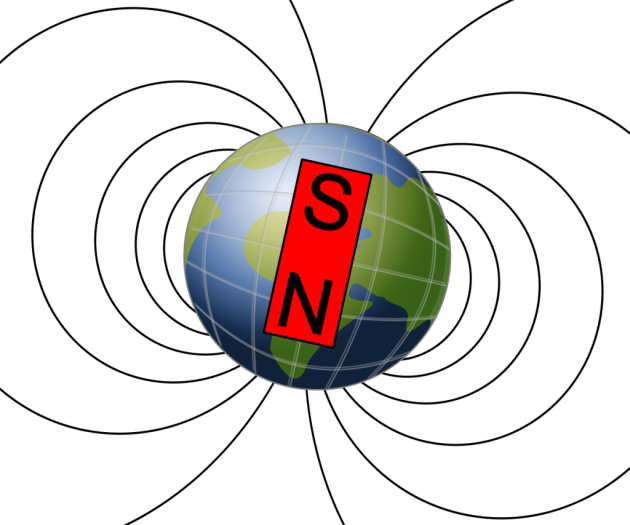What are magnetic poles, what is the difference between the north and south magnetic poles
Magnetic pole Is a useful concept from magnetic field theory similar to the concept electric charge… Definitions North and South with respect to such poles within this analogy correspond to the definitions of charge as positive and negative.
Just as there is a repulsive force between two electrons and an attractive force between an electron and a proton, there is a repulsive force between the two magnetic north poles and an attractive force between the north and south poles.

Magnetic fields can be described using lines of magnetic flux or lines of force… This concept is related to the hypothetical behavior of a single moving north pole in an external magnetic field.
If such a pole existed, then under the specified conditions it would tend to move in the direction of the field at any point in space and would describe trajectories called lines of force. A single south pole moves along the lines of force in the opposite direction to the direction of movement of a single north pole.
The movement of a unit pole along the lines of force is a consequence of the action of the Coulomb force, and the influence of one of the two unit poles is replaced by the influence of an equivalent magnetic field.
The force applied to a pole is the result of the interaction of its own local field with the field existing in the surrounding space.
Although the strength of this external field is felt by a given pole, the location of the source of the external field need not be known if only the force acting on a given pole is considered.
The external field simply affects the pole located at a given point in space. The intensity of the response of one pole to the effect of an external field determines the quantitative measure relative to which the intensity of this external field.
So, both electric and magnetic fields can be depicted in general terms using lines of force. Unit electric charges tend to move along electric lines of force and single magnetic poles — along magnetic lines of force… There is, however, a fundamental difference between these two types of force lines.
Specifically, there are two types of electrically charged particles, positive and negative, and each type of particle acts as a source of electrical current.
If there are particles of both types in space, then the electric lines of force start on particles of one type and end on particles of the other type. Under these conditions, every electric field line has a beginning, an end, and a direction.
If there are electrically charged particles of only one type, then electric lines of force extend between those particles and infinity. In this case, each line of force has a beginning and a direction, but no end.
A magnetic field line, unlike an electric field, although it has a direction, has no beginning or end. Magnetic field lines are always continuous. As a result, there cannot be a single magnetic pole in the form of a particle, analogous to a single charge, which is represented by an electron or a proton.
Although the concepts of north and south unit magnetic poles are useful for quantifying magnetic fields, such particles cannot exist in nature. However, magnetic field lines can exit one end of the body and enter the other end. In these cases it is said that this body is magnetically polarized.
Similarly, a body is electrically polarized if electric field lines exit from one end of it and enter at the other end.
In electric polarization, the electric field line starts at a certain point inside the polarized body. The end of the force line is assigned to some specific electron or specific proton. In the case of magnetic polarization, the magnetic field line simply passes through the body, and inside that body there are no points at which it would begin or end.
As an example, consider the magnetic field around it tape magnet… This field has its greatest strength at both ends of the rod.
At first glance, this might imply the presence of some sources of magnetic field inside the rod at its ends—the north pole at one end and the south pole at the other.
However, such an idea develops only when observed from the outside, since in fact the field has the greatest strength in the central part of the metal rod, and not at its ends. So here the magnetic poles characterize the points of entry and exit of the lines of force, not in any way the points of their beginning or end.
The names north and south were created as a result of historical association. The Earth's magnetic field is oriented so that its poles are physically located in close proximity to the geographic poles.
In fact, the compass needle points to the geographic north pole at many points on earth. In the minds of many people, these two completely different concepts (geographic and magnetic poles) merge into one.
But even using the accepted convention as to the north and south poles, there still remains some ambiguity, owing to the necessity of distinguishing between the pole oriented in the north direction, which is the true north pole of a magnet, and the south magnetic pole, which , in terms of its properties, would correspond to the geographic north pole, if indeed there were a physically defined single pole.
In short, although a body can be polarized so that magnetic field lines exit at one end and enter at the other end, objects such as a magnetic monopole do not exist.
Continuing this article: What is the pole of the current source



